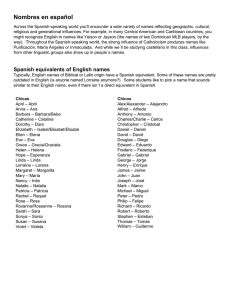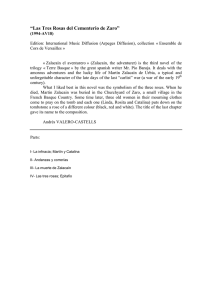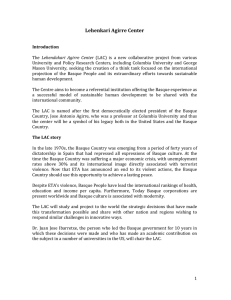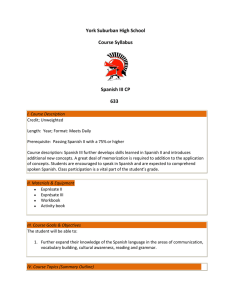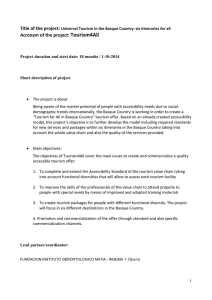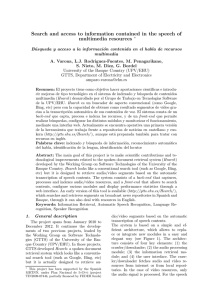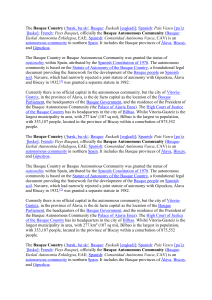basque, spanish and english: three languages in contact in the
Anuncio
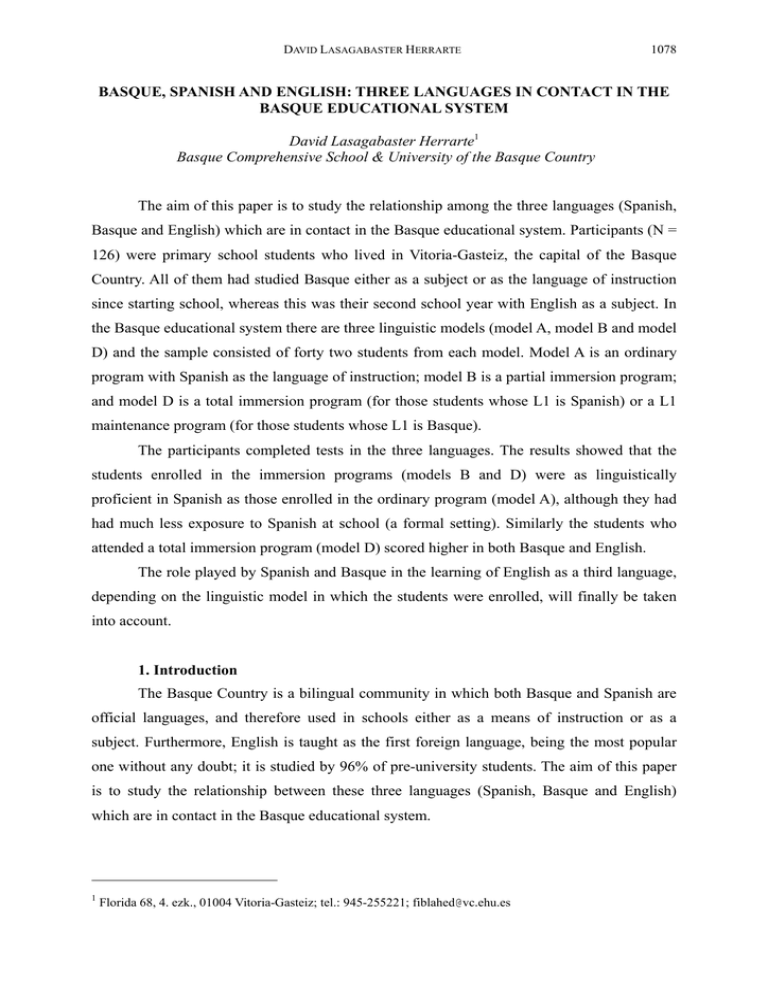
DAVID LASAGABASTER HERRARTE 1078 BASQUE, SPANISH AND ENGLISH: THREE LANGUAGES IN CONTACT IN THE BASQUE EDUCATIONAL SYSTEM David Lasagabaster Herrarte1 Basque Comprehensive School & University of the Basque Country The aim of this paper is to study the relationship among the three languages (Spanish, Basque and English) which are in contact in the Basque educational system. Participants (N = 126) were primary school students who lived in Vitoria-Gasteiz, the capital of the Basque Country. All of them had studied Basque either as a subject or as the language of instruction since starting school, whereas this was their second school year with English as a subject. In the Basque educational system there are three linguistic models (model A, model B and model D) and the sample consisted of forty two students from each model. Model A is an ordinary program with Spanish as the language of instruction; model B is a partial immersion program; and model D is a total immersion program (for those students whose L1 is Spanish) or a L1 maintenance program (for those students whose L1 is Basque). The participants completed tests in the three languages. The results showed that the students enrolled in the immersion programs (models B and D) were as linguistically proficient in Spanish as those enrolled in the ordinary program (model A), although they had had much less exposure to Spanish at school (a formal setting). Similarly the students who attended a total immersion program (model D) scored higher in both Basque and English. The role played by Spanish and Basque in the learning of English as a third language, depending on the linguistic model in which the students were enrolled, will finally be taken into account. 1. Introduction The Basque Country is a bilingual community in which both Basque and Spanish are official languages, and therefore used in schools either as a means of instruction or as a subject. Furthermore, English is taught as the first foreign language, being the most popular one without any doubt; it is studied by 96% of pre-university students. The aim of this paper is to study the relationship between these three languages (Spanish, Basque and English) which are in contact in the Basque educational system. 1 Florida 68, 4. ezk., 01004 Vitoria-Gasteiz; tel.: 945-255221; [email protected] ACTAS DO I SIMPOSIO INTERNACIONAL SOBRE O BILINGÜISMO 1079 This study was completed in Vitoria-Gasteiz, the capital of the Basque Autonomous Community (CAV) and one of the areas where Basque is less widely used, which could affect the results obtained in Basque by those children enrolled in bilingual programs. The presence of these languages in the curriculum is allocated according to three linguistic models: Model A: In this model Spanish is the means of instruction, whereas Basque (5 hours per week) and English (3 hours per week) are taught as school subjects. Spanish is the mother tongue of these students. Model B: Both Spanish and Basque are vehicle languages. English is a subject (3 hours per week). Most students have Spanish as their mother tongue. Model D: Basque is the vehicle language, whereas Spanish (5 hours per week) and English (3 hours per week) are subjects. Students may have Spanish or Basque as their mother tongue. There are some studies which have examined the competence in Spanish and Basque taking into account these linguistic models. The most outstanding ones are the so-called EIFEs. These were three studies (Gabiña et al., 1986; Sierra & Olaziregi, 1989; Sierra & Olaziregi, 1990) carried out with a large number of participants by the Basque government’s Department of Education. In these studies the results showed that whereas there were no significant differences as far as the competence in Spanish was concerned, those students enrolled in model D achieved the best scores in Basque, followed by the model B students. Model A students’ command of the Basque language, however, turned out to be very poor. Thus, the students enrolled in a total immersion program (model D) can be considered as the more balanced bilinguals, for they achieve a very similar level of competence in both Basque and Spanish. These results provided evidence that learning in Basque did not detrimentally affect competence in Spanish (Idiazabal, 1993), in spite of the fact that students enrolled in immersion programs had much less exposure to Spanish in a formal setting. Since Basque is a minority language in our community, its use as a means of instruction does not act as a hindrance to the development of competence in the majority language, Spanish; a language which plays a very important social role. On the other hand, only two studies (Cenoz, 1991; Lasagabaster & Cenoz, 1996) had been carried out within the Basque Autonomous Community dealing with the competence in the third language present in the curriculum, i. e., English. In both cases the subjects were studying in models A and D, and their results coincide in that model D students achieved DAVID LASAGABASTER HERRARTE 1080 higher scores in the foreign language than model A students. In consequence, it can be concluded that the use of the minority language as a means of instruction does not hinder the learning of the L3, in this case the foreign language, English. Nevertheless, no study has examined model B students’ proficiency in English. 2. Hypotheses This study puts forward the following two hypotheses: 2.1. The students enrolled in immersion programs (models B and D) will obtain results in Spanish similar to those of students enrolled in the ordinary program (model A). Likewise, it is also hypothesized that the students who attended a total immersion program will obtain higher scores in both Basque and English. This first hypothesis is based on the empirical data referred to at the beginning of the paper. Vitoria-Gasteiz is a city were the presence of Basque is very limited. The fact that immersion students have less exposure to Spanish should not negatively affect their proficiency in this latter language, since Spanish is the majority language. At the same time, as total immersion students (model D) are supposed to be more balanced than those who attend an ordinary program (model A), this balanced bilingualism should have positive effects on their command of the English language (Cenoz, 1991). 2.2. There will be a close relationship between the language of instruction and English in each of the three linguistic models. Since the learning of the foreign language takes place in a formal setting (school), it is supposed that there will be a closer relationship between the vehicle language and English than between the language taught only as a subject and English. This second hypothesis could not be based on any previous research, since we have no knowledge of any study dealing with this issue within or outside our context. 3. Methodology 3.1. The sample: the participants were 126 grade 5 students (10 and 11 years old) and this was the second school year with English as a subject for all of them. The three groups were matched on age, sex, school grade, English classes outside school and social class. As for intelligence, model B students scored significantly lower than model A and D students, a factor to take into consideration when analysing the results of this linguistic model. 3.2. The instruments: before completing the language tests, all the subjects carried out the Raven’s Progressive Matrices Test so that general intelligence could be measured, as well ACTAS DO I SIMPOSIO INTERNACIONAL SOBRE O BILINGÜISMO 1081 as a general questionnaire with questions related to personal data (age, gender, attendance at extra-scholastic classes, parental occupation, etc). Both competence in Spanish and Basque were assessed via standardized tests (Olaziregi & Sierra, 1988; Sierra & Olaziregi, 1986). In these tests students had to complete listening, reading and writing activities. For the listening activity students were read ten sentences, each sentence having 4 pictures from which they had to choose the right one. The reading activity was made up of ten sentences, each with multiple choice endings. The writing activity consisted in writing a story based on six pictures. Competence in English was controlled through a test consisting of four main parts. The first part of the test dealt with vocabulary and grammar; they were asked to match some labels with the parts of the body and others with clothes; they also had to write the name of various items (they were shown several pictures), put a dialogue in order and complete the days of the week. In the second part students were shown two pictures and according to them had to join the begining of a sentence with the most appropriate ending among several possibilities. They also had to read a text about an alien and answer some multiple choice questions. The third part consisted in choosing the correct answer in a multiple choice activity, once having listened to a tape about a boy called John. Finally, the subjects were shown a set of six pictures about which they had to talk. Since oral production is one of the most difficult tasks for second language learners, it was endeavoured to include in the pictures objects for which the vocabulary should have been familiar (parts of the house, pets, the family, clothes, etc.). By doing this, it was hoped that every student would be capable of speaking for at least a short while. There was no English writing test, since it would have been rather complex for students who were in their second year of learning at school. The communicative approach used nowadays in the teaching of the foreign language places more emphasis during these first years on listening and speaking skills. As a result, students would not have known how to face such an activity and the possible results and differences between groups would not have been meaningful. 3.3. The method: the participants were tested in three sessions. In the first session the Basque proficiency test and the Raven’s Matrices Test were carried out. The second session was dedicated to the Spanish proficiency test and the general questionnaire. These two sessions lasted 45 minutes. The final session took about an hour and consisted of the English test. The only test that took place in a separate room and individually was the oral test in English, which was recorded on tape. DAVID LASAGABASTER HERRARTE 1082 Once all these tests had been completed they were marked and codified so that they could undergo statistical treatment. We resorted to the SPSS (Statistical Package for Social Sciences) to perform all the statistical analyses. 4. Results Firstly we set out to analyse the proficiency shown by the students in the three languages present in the curriculum depending on the linguistic model in which the student were enrolled. Since these tests consisted of several parts, some of them with different evaluation scales, we fell back on Z-scores in order to achieve an average general score in each language. Anova analyses proved that the differences between the three linguistic models were significant as for Basque and English, but not as for Spanish: Table 1. F Spanish .671 Basque 750.640** English **p < .001 4.156* *p < .05 The following graph shows the scores obtained by the students of each of these models in the three languages: Graph 1 0,87 1 0,39 0,5 0,21 0,08 0 0,01 -0,04 -0,09 SPANISH BASQUE ENGLISH -0,29 -0,5 -1 -1,27 -1,5 MODEL A MODEL B MODEL D ACTAS DO I SIMPOSIO INTERNACIONAL SOBRE O BILINGÜISMO 1083 As far as proficiency in Spanish was concerned, model B students achieved the highest scores, model D students came second and model A students obtained the lowest scores. And this despite the fact that immersion students (models B and D) have less teaching time in Spanish. Nevertheless, it has to be borne in mind that the differences between these groups were not significant (F = .671). On the contrary, the results in Basque did show significant differences. T-tests analyses showed that model D outperformed models B {t(82) = 7.95, p < .001} and A {t(82) = 46.23, p < .001}, whereas model B outperformed model A {t(82) = 25.40, p < .001}. These results were as expected, since the amount of time in which a language is used as a vehicle language exerts a great influence on the competence achieved in that language. Regarding proficiency in English, T-test analyses only revealed significant differences in favour of the model D students with respect to the model A ones {t(82) = 3.08, p < .01}. Although the model D students scored higher than the model B ones, this difference did not turn out to be significant. The differences between model B and model A scores were not significant either. Table 2 exhibits the results regarding the second of our hypotheses, that concerning the relationship between the language of instruction of each linguistic model and English. Once multiple regression analyses were performed the results were as follows: Table 2 Multiple regression (method = stepwise) Dependent variable = English Model B Model A Spanish R2 T S .36 4.79 .000 R2 Basque .53 T R2 S 6.82 .000 Model D Basque .19 T S 3. 12 .003 In both model A and model D our hypothesis is borne out, for there is a close relationship between the language of instruction and English. However, in model B both the vehicle languages (Basque and Spanish) should have appeared as significantly related to English, but this is not the case. Spanish has no significant relationship whatsoever with English. The explanation could be in the fact that Basque as a vehicle language takes more time (70% of the curriculum) than Spanish (only 30%). DAVID LASAGABASTER HERRARTE 1084 5. Conclusions Our first hypothesis is supported by these results, as it is demonstrated that the ample attention given to the L1 when it is a minority language (as in the case of Basque) does not impede in any way the normal acquisition of an L2 or L3. Similarly, the acquisition of an L2 or an L3 does not impede the normal development of the L1 when this is a majority language (as in the case of Spanish). In fact, the model D students achieve higher scores in the three languages than the model A ones. With respect to our second hypothesis it can be concluded that there is a closer relationship between the language of instruction and English than between the language taught as a subject and English, except in the case of model B, where competence in Spanish does not have a close relationship with English. This may be due to the fact that there is much more exposure to Basque than to Spanish. More research is needed, particularly in the case of this second hypothesis, in order to shed light on the relationship between the languages present in the curriculum, whether this relationship is due to using the language as a means of instruction or to the typological relatedness between the languages involved, and whether it varies according to the age and the development of a greater metalinguistic awareness of older students facing a threelanguage-in-contact situation. References Cenoz, M.A. (1991), Enseñanza-aprendizaje del inglés como L2 o L3, Tesis doctoral, Donostia, Universidad del País Vasco. Gabiña, J.J., R. Gorostidi, R. Iruretagoiena, I. Olaziregi, J. Sierra (1986), EIFE-1 Euskararen irakaskuntza: faktoreen eragina, Vitoria-Gasteiz, Hezkuntza, Unibertsitate eta Ikerketa Saila. Idiazabal, I. (1993), “Hezkuntza eremuko lege berriak eta euskararen normalkuntza: zenbait gogoeta”, BAT-Soziolinguistika Aldizkaria 10, 11-21. Lasagabaster, D., J. Cenoz (1996), “Language learning in the Basque Country: Immersion versus non-immersion programs”, Paper presented at the III European Conference on Immersion Programmes, Barcelona. Olaziregi, I., J. Sierra (1988), Galbahe-E2 hizkuntz testa. Gida liburua, Vitoria-Gasteiz, Hezkuntza, Unibertsitate eta Ikerketa Saila. Sierra, J., I. Olaziregi (1986), Galbahe-C1 y C2. Tests de lengua, Vitoria-Gasteiz, Hezkuntza, Unibertsitate eta Ikerketa Saila. __ (1989), EIFE-2 Euskararen irakaskuntza: faktoreen eragina, Vitoria-Gasteiz, Hezkuntza, Unibertsitate eta Ikerketa Saila. ACTAS DO I SIMPOSIO INTERNACIONAL SOBRE O BILINGÜISMO 1085 __ (1990), EIFE-3 Euskararen irakaskuntza: faktoreen eragina, Vitoria-Gasteiz, Hezkuntza, Unibertsitate eta Ikerketa Saila.
